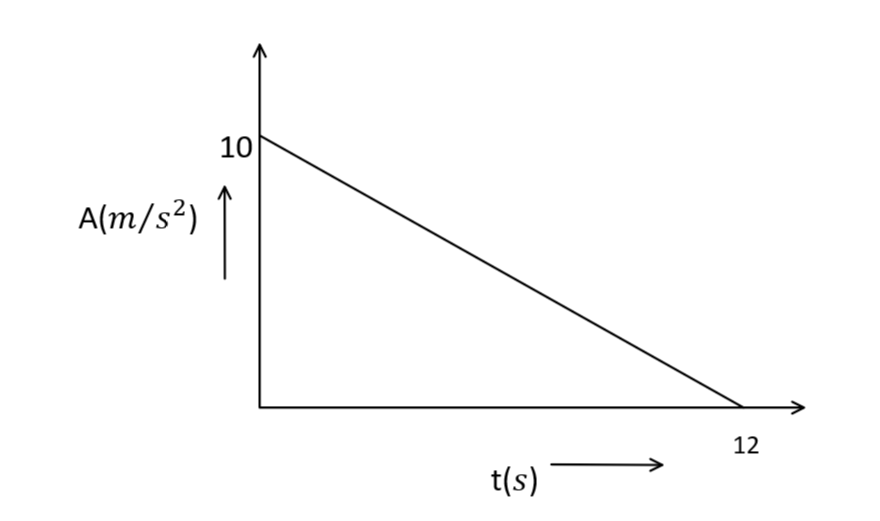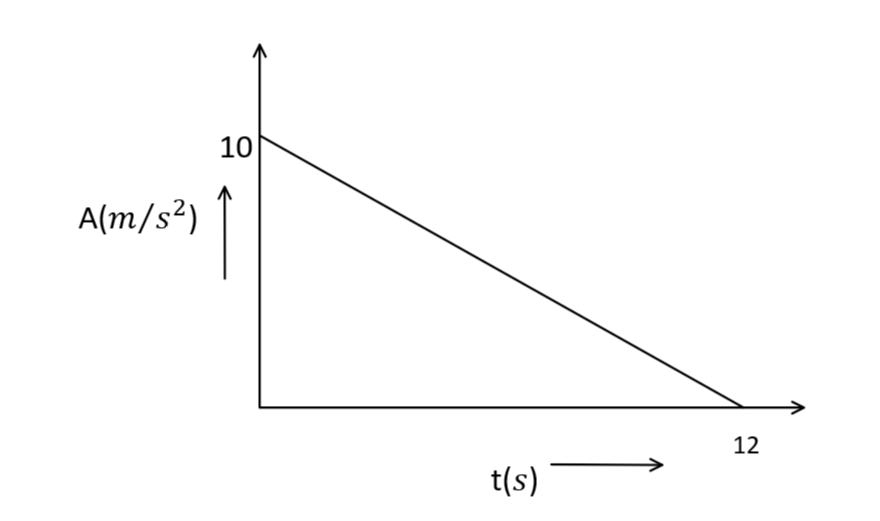
A particle starting from rest undergoes a rectilinear motion with acceleration\[a\]. The variation of \[a\]with time is shown below. The maximum velocity attained by the particle during its motion is

A) \[120\,m\]/\[s\]
B) \[60\,m\]/\[s\]
C) \[22\,m\]/\[s\]
D) \[80\,m\]/\[s\]
Answer
217.2k+ views
Hint: In this question, we have to find the maximum velocity during the rectilinear motion with acceleration\[a\]. For that we have to find the area under the curve where acceleration \[a\]has the maximum value
Complete step by step answer:

In this question, we have to find the maximum velocity during the rectilinear motion with acceleration (\[a\])
Since, we know that
\[a = \dfrac{{dv}}{{dt}}\]
Or we can write the above equation as,
\[v = \int {a.dt} \]
Therefore, for finding the maximum velocity we have to find the area under the curve where \[a\]is maximum
As we can see in the graph the maximum value of a is \[10\,m\]/\[s\]
Now, since the graph is in the form of triangle, area under the curve will be, \[\dfrac{1}{2} \times X - axis\, \times \,Y - axis\]
On putting the values we get,
\[\dfrac{1}{2} \times 10\, \times \,12 = 60\]
Hence, the maximum velocity during the rectilinear motion with acceleration (\[a\]) will be \[60\,m\]/\[{s^2}\]
Note: For this type of question, the best method to solve is to find the area under the curve for the required intervals by integration or else we can do it by the normal method as we did in the above question.
Complete step by step answer:

In this question, we have to find the maximum velocity during the rectilinear motion with acceleration (\[a\])
Since, we know that
\[a = \dfrac{{dv}}{{dt}}\]
Or we can write the above equation as,
\[v = \int {a.dt} \]
Therefore, for finding the maximum velocity we have to find the area under the curve where \[a\]is maximum
As we can see in the graph the maximum value of a is \[10\,m\]/\[s\]
Now, since the graph is in the form of triangle, area under the curve will be, \[\dfrac{1}{2} \times X - axis\, \times \,Y - axis\]
On putting the values we get,
\[\dfrac{1}{2} \times 10\, \times \,12 = 60\]
Hence, the maximum velocity during the rectilinear motion with acceleration (\[a\]) will be \[60\,m\]/\[{s^2}\]
Note: For this type of question, the best method to solve is to find the area under the curve for the required intervals by integration or else we can do it by the normal method as we did in the above question.
Recently Updated Pages
Introduction to Dimensions: Understanding the Basics

[Awaiting the three content sources: Ask AI Response, Competitor 1 Content, and Competitor 2 Content. Please provide those to continue with the analysis and optimization.]

JEE Atomic Structure and Chemical Bonding important Concepts and Tips

JEE Amino Acids and Peptides Important Concepts and Tips for Exam Preparation

Electricity and Magnetism Explained: Key Concepts & Applications

Chemical Properties of Hydrogen - Important Concepts for JEE Exam Preparation

Trending doubts
JEE Main 2026: Application Form Open, Exam Dates, Syllabus, Eligibility & Question Papers

Derivation of Equation of Trajectory Explained for Students

Hybridisation in Chemistry – Concept, Types & Applications

Understanding the Angle of Deviation in a Prism

Understanding Collisions: Types and Examples for Students

How to Convert a Galvanometer into an Ammeter or Voltmeter

Other Pages
JEE Advanced Marks vs Ranks 2025: Understanding Category-wise Qualifying Marks and Previous Year Cut-offs

Units And Measurements Class 11 Physics Chapter 1 CBSE Notes - 2025-26

NCERT Solutions For Class 11 Physics Chapter 8 Mechanical Properties Of Solids

Motion in a Straight Line Class 11 Physics Chapter 2 CBSE Notes - 2025-26

NCERT Solutions for Class 11 Physics Chapter 7 Gravitation 2025-26

Understanding Atomic Structure for Beginners




